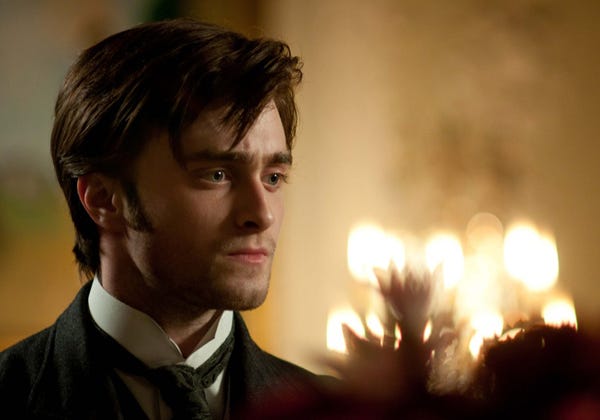The Woman in Black

“The Woman in Black” boasts meticulously macabre production design that’s sumptuous to gaze at and ominous atmospherics that carry it through the first act. But shouldn’t we expecto muchmorum from Daniel Radcliffe’s first big post-Harry Potter production than a super frowny-faced, well-mounted Gothic spin on “The Grudge”?
With a plot shaped together from the ectoplasmic goop of countless haunted-house stories before it, “The Woman in Black” lives and dies in the telling of its tale. Except for preteens lured in by Radcliffe’s presence for an introduction to moody “Hammer horror,” this early-20th-century ghost story won’t have much of an afterlife after leaving theaters.
Arguably, its biggest shocker is Radcliffe playing someone allegedly old enough to have A) built a reasonably respectable legal career now in tatters and B) fathered a 4-year-old. It’s not Radcliffe’s fault that he looks fresh out of high school — a quality that makes him feel as vulnerable as he is likeable. But still, those boyish features are a distracting counterpoint to his character’s decaying soul.
Fate has been unkind to Arthur Kipps — stealing the life of his beloved right as she’s birthed their baby boy in London. The shellshock has lasted four years, and advertisements touting the accessibility of the spirit world don’t help matters.
Worst of all, it’s dragged down Arthur’s performance at work, where his boss has issued an ultimatum: Settle the estate of the late Alice Drablow or pack it in. It seems easy enough — so much so that Arthur is having his son sent up for a weekend holiday there once he’s finished.
However, tightlipped, hostile citizens populate the bleak, watery hamlet of Crythin Gifford — unwilling to divulge information about Alice Drablow or even take him to her estate, named Eel Marsh. Arthur gets there eventually, and he’s beset by visions of the title character, which goes bump and boom to keep him from seeking Alice Drablow’s last will and testament. (Call it “Paranormal Paralegal Activity.”)
Is she Alice Drablow? Is it someone else? Is she connected to the surplus of dying kids in Crythin Gifford? Will the dog Arthur has borrowed from a friend sniff out supernatural presences he can’t sense? Should Arthur telegraph his nanny and tell her to leave his son at home? Have you ever seen a horror movie before?
Director James Watkins offers a visual presentation of Eel Marsh that’s infinitely more unnerving than any supernatural secrets Arthur uncovers there.
Eel Marsh sits off a causeway washed out by the tide for a few hours every day — effectively rendering the property a spooky island. The muddy vistas of Eel Marsh are as beguiling as they are barbaric — surely the result of visual effects, but good luck spotting the seams. And the house itself — seemingly held together by cobwebs — represents a jolly good show of production design by Kave Quinn.
The desolate moors are deadly. Unfortunately, so is the pacing of the script by Jane Goldman (“Kick-Ass” and “X-Men: First Class”). You can almost see glaciers cutting grooves into those muddy, grassy lands.
It attempts to compensate with a pushy score by Marco Beltrami and an overstuffing of cheapjack scares. But a dialogue-free second act amounts to Radcliffe going up and down stairs to stare at spooky things and it takes forever to make clear mysteries that are easily pieced together.
Radcliffe soldiers on through all of this with resolve, and “The Woman in Black” is never boring to simply look at. But it stretches its oh-come-on-no-way ridiculousness to the point of exhaustion before an admittedly effective conclusion.
Were “The Woman in Black” part of a horror anthology, those final moments would have been stronger (and faster reached). As it is, the endless slog of midnights dreary will likely make you weak and weary.


